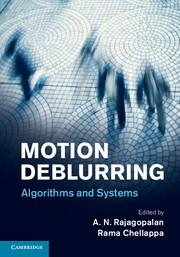Book contents
- Frontmatter
- Contents
- List of contributors
- Preface
- 1 Mathematical models and practical solvers for uniform motion deblurring
- 2 Spatially-varying image deblurring
- 3 Hybrid-imaging for motion deblurring
- 4 Efficient, blind, spatially-variant deblurring for shaken images
- 5 Removing camera shake in smartphones without hardware stabilization
- 6 Multi-sensor fusion for motion deblurring
- 7 Motion deblurring using fluttered shutter
- 8 Richardson–Lucy deblurring for scenes under a projective motion path
- 9 HDR imaging in the presence of motion blur
- 10 Compressive video sensing to tackle motion blur
- 11 Coded exposure motion deblurring for recognition
- 12 Direct recognition of motion-blurred faces
- 13 Performance limits for motion deblurring cameras
- Index
- References
12 - Direct recognition of motion-blurred faces
Published online by Cambridge University Press: 05 June 2014
- Frontmatter
- Contents
- List of contributors
- Preface
- 1 Mathematical models and practical solvers for uniform motion deblurring
- 2 Spatially-varying image deblurring
- 3 Hybrid-imaging for motion deblurring
- 4 Efficient, blind, spatially-variant deblurring for shaken images
- 5 Removing camera shake in smartphones without hardware stabilization
- 6 Multi-sensor fusion for motion deblurring
- 7 Motion deblurring using fluttered shutter
- 8 Richardson–Lucy deblurring for scenes under a projective motion path
- 9 HDR imaging in the presence of motion blur
- 10 Compressive video sensing to tackle motion blur
- 11 Coded exposure motion deblurring for recognition
- 12 Direct recognition of motion-blurred faces
- 13 Performance limits for motion deblurring cameras
- Index
- References
Summary
The need to recognize motion-blurred faces is vital for a wide variety of security applications ranging from maritime surveillance to road traffic policing. While much of the theory in the analysis of motion-blurred images focuses on restoration of the blurred image, we argue that this is an unnecessary and expensive step for face recognition. Instead, we adopt a direct approach based on the set-theoretic characterization of the space of motion-blurred images of a single sharp image. This set lacks the nice property of convexity that was exploited in a recent paper to achieve competitive results in real-world datasets (Vageeswaran, Mitra & Chellappa 2013). Keeping this non-convexity in mind, we propose a bank of classifiers (BoC) approach for directly recognizing motion-blurred face images. We divide the parameter space of motion blur into many different bins in such a way that the set of blurred images within each bin is a convex set. In each such bin, we learn support vector machine (SVM) classifiers that separate the convex sets associated with each person in the gallery database. Our experiments on synthetic and real datasets provide compelling evidence that this approach is a viable solution for recognition of motion-blurred face images.
Introduction
A system that can recognize motion-blurred faces can be of vital use in a wide variety of security applications, ranging from maritime surveillance to road traffic policing. Figure 12.1 shows two possible maritime surveillance scenarios: shore-to-ship (the camera is mounted on-shore and the subjects are in the ship), and ship-to-shore (the camera is on the ship and the subjects are moving on-shore).
- Type
- Chapter
- Information
- Motion DeblurringAlgorithms and Systems, pp. 246 - 257Publisher: Cambridge University PressPrint publication year: 2014
References
- 1
- Cited by



